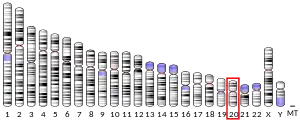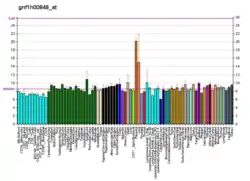| COX4I2 | |||||||||||||||||||||||||||||||||||||||||||||||||||
|---|---|---|---|---|---|---|---|---|---|---|---|---|---|---|---|---|---|---|---|---|---|---|---|---|---|---|---|---|---|---|---|---|---|---|---|---|---|---|---|---|---|---|---|---|---|---|---|---|---|---|---|
| Identifiers | |||||||||||||||||||||||||||||||||||||||||||||||||||
| Aliases | COX4I2, COX4, COX4-2, COX4B, COX4L2, COXIV-2, dJ857M17.2, cytochrome c oxidase subunit 4I2 | ||||||||||||||||||||||||||||||||||||||||||||||||||
| External IDs | OMIM: 607976 MGI: 2135755 HomoloGene: 13082 GeneCards: COX4I2 | ||||||||||||||||||||||||||||||||||||||||||||||||||
| |||||||||||||||||||||||||||||||||||||||||||||||||||
| |||||||||||||||||||||||||||||||||||||||||||||||||||
| |||||||||||||||||||||||||||||||||||||||||||||||||||
| |||||||||||||||||||||||||||||||||||||||||||||||||||
| |||||||||||||||||||||||||||||||||||||||||||||||||||
| Wikidata | |||||||||||||||||||||||||||||||||||||||||||||||||||
| |||||||||||||||||||||||||||||||||||||||||||||||||||
Cytochrome c oxidase subunit 4 isoform 2, mitochondrial is an enzyme that in humans is encoded by the COX4I2 gene.[5][6] COX4I2 is a nuclear-encoded isoform of cytochrome c oxidase (COX) subunit 4. Cytochrome c oxidase (complex IV) is a multi-subunit enzyme complex that couples the transfer of electrons from cytochrome c to molecular oxygen and contributes to a proton electrochemical gradient across the inner mitochondrial membrane, acting as the terminal enzyme of the mitochondrial respiratory chain. Mutations in COX4I2 have been associated with exocrine pancreatic insufficiency, dyserythropoietic anemia, and calvarial hyperostosis (EPIDACH).[7][8]
Structure
COX4I2 is located on the q arm of chromosome 20 in position 11.21 and has 6 exons.[7] The COX4I2 gene produces a 20 kDa protein composed of 171 amino acids.[9][10] The protein encoded by COX4I2 belongs to the cytochrome c oxidase IV family. COX4I2 has a transit peptide domain and a disulfide bond amino acid modification.[11][12] A Glu138 residue, which corresponds to a Glu136 residue in COX4I1, is believed to be highly conserved and structurally important for the mitochondrial COX response to hypoxia.[8]
Function
Cytochrome c oxidase (COX), the terminal enzyme of the mitochondrial respiratory chain, catalyzes the electron transfer from reduced cytochrome c to oxygen. It is a heteromeric complex consisting of 3 catalytic subunits encoded by mitochondrial genes and multiple structural subunits encoded by nuclear genes. The mitochondrially-encoded subunits function in electron transfer, and the nuclear-encoded subunits may be involved in the regulation and assembly of the complex. The COX4I2 nuclear gene encodes isoform 2 of subunit IV. Isoform 1 of subunit IV is encoded by a different gene, however, the two genes show a similar structural organization. Subunit IV is the largest nuclear encoded subunit which plays a pivotal role in COX regulation. It is located on the inner mitochondrial membrane on the matrix side. Expression of COX4I2 is highest in the placenta and the lungs.[7][11][12] Additionally, the expression of COX4I2, along with COX4I1, may be regulated by oxygen levels, with reduced levels of oxygen leading to increased COX4I2 expression and COX4I1 degradation. This suggests a role for COX4I2 in the optimization of the electron transfer chain under different conditions.[13]
Clinical Significance
Mutations in COX4I2 have been associated with exocrine pancreatic insufficiency, dyserythropoeitic anemia, and calvarial hyperostosis (EPIDACH). Characteristics of this disease include pancreatic insufficiency, intestinal malabsorption, failure to thrive, and anemia soon after birth. Additional symptoms have included steatorrhea, splenomegaly and hepatomegaly, pancreatic atrophy, generalized muscle hypotonia, hyperostosis, yellowish sclera associated with mild indirect hyperbilirubinemia, impaired coagulation functions, elevated LDH, alanine, and bilirubin, and reduced vitamin E levels. A homozygous mutation, E138K, has been found to result in reduced COX4I2 expression (25% in fibroblasts) and an impaired response to hypoxia. Functional COX4I2 expression below 40% of its normal level is predicted to be rate-limiting, with the E138K mutation occurring in what is believed to be a highly conserved residue of subunit IV.[11][12][8]
Interactions
COX4I2 has been shown to interact with Cytochrome c (CYCS).[14][15][16][17] Additionally, APP, COA3, and KRAS have been found to have protein-protein interactions with COX4I2.[18]
References
- 1 2 3 GRCh38: Ensembl release 89: ENSG00000131055 - Ensembl, May 2017
- 1 2 3 GRCm38: Ensembl release 89: ENSMUSG00000009876 - Ensembl, May 2017
- ↑ "Human PubMed Reference:". National Center for Biotechnology Information, U.S. National Library of Medicine.
- ↑ "Mouse PubMed Reference:". National Center for Biotechnology Information, U.S. National Library of Medicine.
- ↑ Hüttemann M, Kadenbach B, Grossman LI (April 2001). "Mammalian subunit IV isoforms of cytochrome c oxidase". Gene. 267 (1): 111–23. doi:10.1016/S0378-1119(01)00385-7. PMID 11311561.
- ↑ Hüttemann M, Lee I, Liu J, Grossman LI (November 2007). "Transcription of mammalian cytochrome c oxidase subunit IV-2 is controlled by a novel conserved oxygen responsive element". The FEBS Journal. 274 (21): 5737–48. doi:10.1111/j.1742-4658.2007.06093.x. PMID 17937768. S2CID 46455551.
- 1 2 3 "Entrez Gene: COX4I2 cytochrome c oxidase subunit IV isoform 2 (lung)".
 This article incorporates text from this source, which is in the public domain.
This article incorporates text from this source, which is in the public domain. - 1 2 3 Shteyer E, Saada A, Shaag A, Al-Hijawi FA, Kidess R, Revel-Vilk S, Elpeleg O (March 2009). "Exocrine pancreatic insufficiency, dyserythropoeitic anemia, and calvarial hyperostosis are caused by a mutation in the COX4I2 gene". American Journal of Human Genetics. 84 (3): 412–7. doi:10.1016/j.ajhg.2009.02.006. PMC 2668012. PMID 19268275.
- ↑ Zong NC, Li H, Li H, Lam MP, Jimenez RC, Kim CS, Deng N, Kim AK, Choi JH, Zelaya I, Liem D, Meyer D, Odeberg J, Fang C, Lu HJ, Xu T, Weiss J, Duan H, Uhlen M, Yates JR, Apweiler R, Ge J, Hermjakob H, Ping P (October 2013). "Integration of cardiac proteome biology and medicine by a specialized knowledgebase". Circulation Research. 113 (9): 1043–53. doi:10.1161/CIRCRESAHA.113.301151. PMC 4076475. PMID 23965338.
- ↑ Yao, Daniel. "Cardiac Organellar Protein Atlas Knowledgebase (COPaKB) —— Protein Information". amino.heartproteome.org. Archived from the original on 2018-08-07. Retrieved 2018-08-06.
- 1 2 3 "COX4I2 - Cytochrome c oxidase subunit 4 isoform 2, mitochondrial precursor - Homo sapiens (Human) - COX4I2 gene & protein". www.uniprot.org. Retrieved 2018-08-06.
 This article incorporates text available under the CC BY 4.0 license.
This article incorporates text available under the CC BY 4.0 license. - 1 2 3 "UniProt: the universal protein knowledgebase". Nucleic Acids Research. 45 (D1): D158–D169. January 2017. doi:10.1093/nar/gkw1099. PMC 5210571. PMID 27899622.
- ↑ Fukuda R, Zhang H, Kim JW, Shimoda L, Dang CV, Semenza GL (April 2007). "HIF-1 regulates cytochrome oxidase subunits to optimize efficiency of respiration in hypoxic cells". Cell. 129 (1): 111–22. doi:10.1016/j.cell.2007.01.047. PMID 17418790. S2CID 2331820.
- ↑ Michel B, Bosshard HR (August 1984). "Spectroscopic analysis of the interaction between cytochrome c and cytochrome c oxidase". The Journal of Biological Chemistry. 259 (16): 10085–91. doi:10.1016/S0021-9258(18)90932-4. PMID 6088481.
- ↑ Wiedemann FR, Vielhaber S, Schröder R, Elger CE, Kunz WS (March 2000). "Evaluation of methods for the determination of mitochondrial respiratory chain enzyme activities in human skeletal muscle samples". Analytical Biochemistry. 279 (1): 55–60. doi:10.1006/abio.1999.4434. PMID 10683230.
- ↑ Sampson V, Alleyne T (December 2001). "Cytochrome c/cytochrome c oxidase interaction. Direct structural evidence for conformational changes during enzyme turnover". European Journal of Biochemistry. 268 (24): 6534–44. doi:10.1046/j.0014-2956.2001.02608.x. PMID 11737208.
- ↑ Lynch SR, Sherman D, Copeland RA (January 1992). "Cytochrome c binding affects the conformation of cytochrome a in cytochrome c oxidase". The Journal of Biological Chemistry. 267 (1): 298–302. doi:10.1016/S0021-9258(18)48493-1. PMID 1309738.
- ↑ Lab, Mike Tyers. "COX4I2 Result Summary | BioGRID". thebiogrid.org. Retrieved 2018-08-06.
External links
- Human COX4I2 genome location and COX4I2 gene details page in the UCSC Genome Browser.
Further reading
- Garber EA, Margoliash E (February 1990). "Interaction of cytochrome c with cytochrome c oxidase: an understanding of the high- to low-affinity transition". Biochimica et Biophysica Acta (BBA) - Bioenergetics. 1015 (2): 279–87. doi:10.1016/0005-2728(90)90032-Y. PMID 2153405.
- Bolli R, Nałecz KA, Azzi A (January 1985). "The interconversion between monomeric and dimeric bovine heart cytochrome c oxidase". Biochimie. 67 (1): 119–28. doi:10.1016/S0300-9084(85)80237-6. PMID 2986725.
- Michel B, Bosshard HR (August 1984). "Spectroscopic analysis of the interaction between cytochrome c and cytochrome c oxidase". The Journal of Biological Chemistry. 259 (16): 10085–91. doi:10.1016/S0021-9258(18)90932-4. PMID 6088481.
- Hare JF, Ching E, Attardi G (May 1980). "Isolation, subunit composition, and site of synthesis of human cytochrome c oxidase". Biochemistry. 19 (10): 2023–30. doi:10.1021/bi00551a003. PMID 6246917.
- Papadopoulou LC, Tsiftsoglou AS (September 1996). "Effects of hemin on apoptosis, suppression of cytochrome c oxidase gene expression, and bone-marrow toxicity induced by doxorubicin (adriamycin)". Biochemical Pharmacology. 52 (5): 713–22. doi:10.1016/0006-2952(96)00349-8. PMID 8765469.
- Vizirianakis IS, Pappas IS, Tsiftsoglou AS (March 2002). "Differentiation-dependent repression of c-myc, B22, COX II and COX IV genes in murine erythroleukemia (MEL) cells". Biochemical Pharmacology. 63 (5): 1009–17. doi:10.1016/S0006-2952(01)00937-6. PMID 11911854.
This article incorporates text from the United States National Library of Medicine, which is in the public domain.




